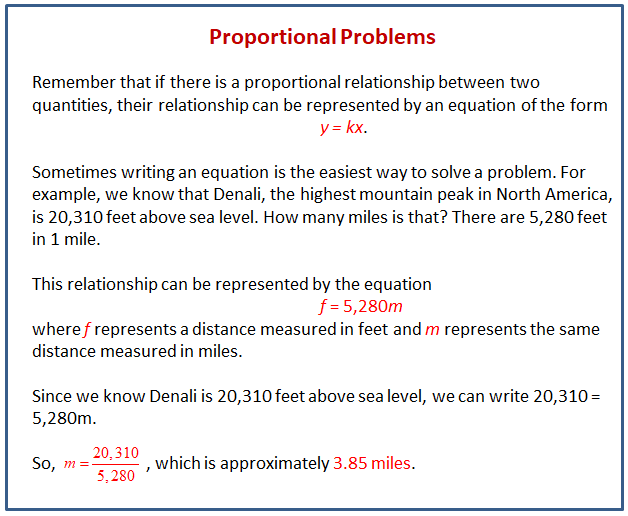Illustrative Mathematics Grade 7, Unit 2, Lesson 6: Using Equations to Solve Problems
Learning Targets:
- I can find missing information in a proportional relationship using the constant of proportionality.
- I can relate all parts of an equation like y = kx to the situation it represents.
Related Pages
Illustrative Math
Grade 7
Lesson 6: Using Equations to Solve Problems
Let’s use equations to solve problems involving proportional relationships.
Illustrative Math Unit 7.2, Lesson 6 (printable worksheets)
Lesson 6 Summary
The following diagram shows how to relate all parts of an equation like y = kx to the situation it represents.

Lesson 6.1 Number Talk: Quotients with Decimal Points
- Without calculating, order the quotients of these expressions from least to greatest.
a. 42.6 ÷ 0.07
b. 42.6 ÷ 70
c. 42.6 ÷ 0.7
d. 426 ÷ 70 - a. Place the decimal point in the appropriate location in the quotient: 42.6 ÷ 7 = 608571
. b. Use this answer to find the quotient of one of the previous expressions.
Lesson 6.2 Concert Ticket Sales
A performer expects to sell 5,000 tickets for an upcoming concert. They want to make a total of $311,000 in sales from these tickets.
- Assuming that all tickets have the same price, what is the price for one ticket?
- How much will they make if they sell 7,000 tickets?
- How much will they make if they sell 10,000 tickets? 50,000? 120,000? a million? tickets?
- If they make $379,420, how many tickets have they sold?
- How many tickets will they have to sell to make $5,000,000?
Lesson 6.3 Recycling
Aluminum cans can be recycled instead of being thrown in the garbage. The weight of 10 aluminum cans is 0.16 kilograms. The aluminum in 10 cans that are recycled has a value of $0.14.
- If a family threw away 2.4 kg of aluminum in a month, how many cans did they throw away? Explain or show your reasoning.
- What would be the recycled value of those same cans? Explain or show your reasoning.
- Write an equation to represent the number of cans c given their weight w.
- Write an equation to represent the recycled value r of c cans.
- Write an equation to represent the recycled value r of w kilograms of aluminum.
Are you ready for more?
The EPA estimated that in 2013, the average amount of garbage produced in the United States was 4.4 pounds per person per day. At that rate, how long would it take your family to produce a ton of garbage? (A ton is 2,000 pounds.)
Lesson 6 Practice Problems
- A car is traveling down a highway at a constant speed, described by the equation d = 65t, where d represents the distance, in miles, that the car travels at this speed in t hours.
a. What does the 65 tell us in this situation?
b. How many miles does the car travel in 1.5 hours?
c. How long does it take the car to travel 26 miles at this speed? - Elena has some bottles of water that each hold 17 fluid ounces.
a. Write an equation that relates the number of bottles of water (b) to the total volume of water (w) in fluid ounces.
b. How much water is in 51 bottles?
c. How many bottles does it take to hold 51 fluid ounces of water? - There are about 1.61 kilometers in 1 mile. Let x represent a distance measured in kilometers and y represent the same distance measured in miles. Write two equations that relate a distance measured in kilometers and the same distance measured in miles.
- In Canadian coins, 16 quarters is equal in value to 2 toonies.
a. Fill in the table.
b. What does the value next to 1 mean in this situation? - Each table represents a proportional relationship. For each table:
a. Fill in the missing parts of the table.
b. Draw a circle around the constant of proportionality. - Describe some things you could notice in two polygons that would help you decide that they were not scaled copies.
The Open Up Resources math curriculum is free to download from the Open Up Resources website and is also available from Illustrative Mathematics.
Try out our new and fun Fraction Concoction Game.
Add and subtract fractions to make exciting fraction concoctions following a recipe. There are four levels of difficulty: Easy, medium, hard and insane. Practice the basics of fraction addition and subtraction or challenge yourself with the insane level.

We welcome your feedback, comments and questions about this site or page. Please submit your feedback or enquiries via our Feedback page.